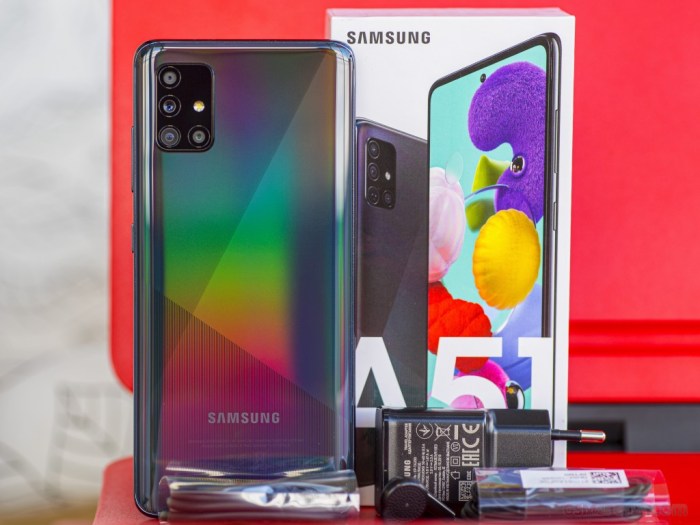Samsung A51 Charger Specification Details
Samsung A51 Charger Specifications
Samsung a51 charger specification – This article provides a comprehensive guide to the Samsung Galaxy A51 charger, covering its specifications, compatible chargers, charging technology, troubleshooting, and safety precautions. Understanding these aspects ensures optimal charging performance and prolongs your phone’s battery life.
Samsung A51 Charger: Key Specifications, Samsung a51 charger specification

Source: maxbhi.com
The original Samsung Galaxy A51 charger typically provides 15W fast charging. While the exact voltage and amperage may vary slightly depending on the region, the standard output is around 5V/2A or 9V/1.67A. The charger uses a USB-C to USB-C cable for connection. The phone is also compatible with other USB-C chargers and even some USB-A chargers (with the appropriate cable), but charging speeds may differ.
| Charger Type | Voltage (V) | Amperage (A) | Charging Speed |
|---|---|---|---|
| Original Samsung 15W Charger (USB-C) | 5/9 | 2/1.67 | Fast Charging (approx. 15W) |
| Generic 10W USB-C Charger | 5 | 2 | Standard Charging (approx. 10W) |
| 25W USB-C Charger | 9 | 2.77 | Faster Charging (approx. 25W, but A51 may not fully utilize this) |
| USB-A Charger (with appropriate USB-C cable) | 5 | 1 | Slow Charging (approx. 5W) |
Understanding Charging Technology
The Samsung Galaxy A51 utilizes Adaptive Fast Charging technology. This technology dynamically adjusts the voltage and amperage to optimize the charging process and minimize charging time. Using a non-original charger might result in slower charging speeds, or even potential damage to the battery in extreme cases. Using a charger with significantly lower power output than the original charger will result in slower charging speeds.
Using a charger with excessively high power output may lead to overheating and damage to the phone’s battery and internal components.
Charger Compatibility and Alternatives
Many third-party USB-C chargers are compatible with the Samsung A51. Choosing a charger with appropriate power delivery capabilities is crucial. It’s important to consider factors like price, brand reputation, and features such as safety certifications.
- Anker PowerPort III Nano: Compact, reliable, and offers fast charging.
- RAVPower 61W PD Charger: A higher-wattage option for faster charging, although the A51 may not utilize the full power.
- Spigen ArcStation Pro: Offers both fast charging and a sleek design.
| Brand | Model | Price (Approximate) | Specifications |
|---|---|---|---|
| Anker | PowerPort III Nano | $15 – $25 | 18W, USB-C PD |
| RAVPower | 61W PD Charger | $30 – $40 | 61W, USB-C PD, Multiple Ports |
| Spigen | ArcStation Pro | $25 – $35 | 18W, USB-C PD, Wireless Charging |
Troubleshooting Charging Issues

Source: imei.org
Several issues can hinder the Samsung A51’s charging process. Addressing these problems effectively is crucial for maintaining optimal phone performance.
- Problem: Phone not charging. Solution: Check the charging cable and port for debris, try a different cable and charger, ensure the outlet is working.
- Problem: Slow charging. Solution: Try a different charger with higher wattage, ensure the phone is not overheating.
- Problem: Intermittent charging. Solution: Check for loose connections, try restarting the phone.
If the problem persists, consider checking for software issues through a factory reset or seeking professional repair to rule out hardware problems such as a faulty charging port or battery.
Power Delivery and Safety
Using a charger with appropriate power delivery (PD) capabilities ensures optimal charging speed and efficiency. Safety precautions are essential to prevent damage to your device and avoid potential hazards.
A typical Samsung A51 charger’s internal components include: a power input connector (receiving AC power), a rectifier circuit (converting AC to DC), a switching regulator (adjusting voltage and current), a USB-C output port, and a protection circuit (safeguarding against overcurrent, overvoltage, and short circuits). The protection circuit is vital for preventing damage to the phone’s battery and circuitry.
The Samsung A51 charger uses a standard USB-C port and supports fast charging, a feature many appreciate. Understanding its specifications is crucial for optimal performance, and this contrasts sharply with the power requirements of larger devices like the Samsung monitor, whose specifications you can find detailed here: samsung 24 ultra specification. Returning to the A51 charger, ensuring you use a compatible adapter is key to avoiding damage and maximizing battery life.
Avoid charging your phone in extreme temperatures (high heat or extreme cold) as this can negatively impact battery health and performance. Always use a charger and cable that are specifically designed for your phone. Never leave your phone charging unattended for extended periods, and always unplug the charger when not in use.
FAQ Overview: Samsung A51 Charger Specification
Can I use a higher wattage charger than the original?
While it might charge faster initially, using a significantly higher wattage charger than recommended could potentially damage the battery in the long run. Stick to chargers within the specified wattage range for optimal battery health.
What happens if I use a damaged charger?
Using a damaged charger can lead to slow charging, overheating, or even damage to your phone’s charging port or battery. Always inspect your charger for any signs of damage before use.
My Samsung A51 is not charging. What should I do?
Try different charging cables and outlets. Check the charging port for any debris. If the problem persists, consider a factory reset or contacting Samsung support.
How often should I calibrate my Samsung A51 battery?
Regular battery calibration isn’t generally necessary for modern smartphones like the Samsung A51. The operating system handles battery management effectively.





















